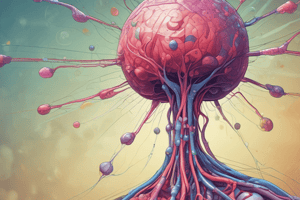Podcast
Questions and Answers
What is the primary function of apoptosis in the human body?
What is the primary function of apoptosis in the human body?
- To repair damaged DNA
- To maintain tissue homeostasis and eliminate damaged cells (correct)
- To slow down cell division
- To eliminate cancer cells
What is the estimated number of cells that die each day in the human adult?
What is the estimated number of cells that die each day in the human adult?
- 20 billion
- 50 billion (correct)
- 100 billion
- 10 billion
What is a characteristic of cancer cells?
What is a characteristic of cancer cells?
- They avoid apoptosis to arise as tumors (correct)
- They divide slowly
- They are impervious to DNA damage
- They undergo excessive apoptosis
What is autophagy?
What is autophagy?
What is the result of too much or too little apoptosis?
What is the result of too much or too little apoptosis?
How much of cells does the human body replace each year?
How much of cells does the human body replace each year?
What occurs within minutes of the apoptotic trigger?
What occurs within minutes of the apoptotic trigger?
Which pathway is also known as the 'death receptor pathway'?
Which pathway is also known as the 'death receptor pathway'?
What is the timeframe for the energy-independent form of cell death?
What is the timeframe for the energy-independent form of cell death?
What is the result of the loss of function of mitochondria and endoplasmic reticulum?
What is the result of the loss of function of mitochondria and endoplasmic reticulum?
What occurs in the later stages of apoptosis?
What occurs in the later stages of apoptosis?
What is the outcome of the release of lysosomal enzymes in apoptosis?
What is the outcome of the release of lysosomal enzymes in apoptosis?
What is the primary function of AIF released by MOMP?
What is the primary function of AIF released by MOMP?
What is the role of APAF-1 in the apoptosome?
What is the role of APAF-1 in the apoptosome?
What is the function of the WD40 motif in APAF-1?
What is the function of the WD40 motif in APAF-1?
What is the consequence of cytochrome c release from mitochondria?
What is the consequence of cytochrome c release from mitochondria?
What is the role of EndoG released by MOMP?
What is the role of EndoG released by MOMP?
What is the function of the CARD domain in APAF-1?
What is the function of the CARD domain in APAF-1?
What is the primary function of the WD40 repeats in the C-terminal region of APAF-1?
What is the primary function of the WD40 repeats in the C-terminal region of APAF-1?
What is the consequence of APAF-1 switching from a 'closed' to an 'open' conformation?
What is the consequence of APAF-1 switching from a 'closed' to an 'open' conformation?
What is the function of the apoptosome?
What is the function of the apoptosome?
What is the characteristic of caspases that allows them to selectively cleave proteins?
What is the characteristic of caspases that allows them to selectively cleave proteins?
What is the role of initiator caspases?
What is the role of initiator caspases?
What is the outcome of the activation of downstream executioner caspases?
What is the outcome of the activation of downstream executioner caspases?
What is the primary function of Fas ligand in the regulation of the immune system?
What is the primary function of Fas ligand in the regulation of the immune system?
What is the outcome of the mitochondrial pathway of apoptosis?
What is the outcome of the mitochondrial pathway of apoptosis?
What is the role of BID in apoptosis?
What is the role of BID in apoptosis?
What is the function of MOMP during apoptosis?
What is the function of MOMP during apoptosis?
What is the primary function of APAF-1?
What is the primary function of APAF-1?
Which pathway is responsible for the majority of apoptosis in vertebrates?
Which pathway is responsible for the majority of apoptosis in vertebrates?
Flashcards are hidden until you start studying
Study Notes
Cell Death
- There are three types of cell death: apoptosis, necrosis, and autophagy
- Apoptosis is a characteristic form of programmed cell death, essential for development, maintenance of tissue homeostasis, and elimination of damaged cells
- 50 billion or more cells die each day in the human adult, and each person replaces around 70 kg of cells every year
Apoptosis
- Apoptosis is a fundamental process that can lead to diseases such as neurodegenerative disorders or cancer if it occurs too much or too little
- Cancer cells must avoid apoptosis for tumors to arise
- Apoptosis is an active, energy-requiring process leading to a characteristic series of morphological changes that accompany the degradation of the cell
Signal Transduction Pathways that Mediate Apoptosis
- There are two pathways that trigger apoptosis: the extrinsic (death receptor pathway) and intrinsic (mitochondrial) apoptotic pathways
- The extrinsic pathway is activated by the engagement of death receptors on the cell surface
- The intrinsic pathway involves the release of cytochrome c and other proteins from the mitochondria
Apoptosome
- The apoptosome is a complex that activates procaspase-9 and is composed of cytochrome c, APAF-1, and procaspase-9
- APAF-1 contains a nucleotide binding domain (NBD), a caspase recruitment domain (CARD), and a long C-terminal extension containing 13 repeats of the WD40 motif
- Formation of the apoptosome leads to the activation of procaspase-9, which can go on to activate downstream executioner caspases
Caspases
- Caspases are highly selective cysteine proteases that have a preference for cleaving proteins after aspartate residues
- Caspases can be grouped into two categories: initiator caspases and effector (or executioner) caspases
- Initiator caspases (e.g. caspase-9) activate effector caspases (e.g. caspase-3 and caspase-7), which eventually lead to cell death
Studying That Suits You
Use AI to generate personalized quizzes and flashcards to suit your learning preferences.




